Instabilities of nanoscale liquid metal
films
(Supported by the NSF Grant CBET-1235710)
Metal films of nanoscale thickness are relevant to a number of
technological fields with applications that include plasmonics,
magnetic nanoparticles, modified surface optical properties, catalysts
for nanowire growth and many others. In many of these
fields ordered arrays of nanoparticles are needed. We are
exploring the mechanism involved in developement of instabilities of
nanoscale metal films exposed to nanoscale laser irradiation, leading
to melting of these films. While in liquid phase, the films
We are
exploring different geometries of metal films and that may lead to such
arrays via self- or directed- assembly, and in particular are
interested in understanding the basic mechanisms that are relevant to
the instabilities and assembly.
Below we outline some of the recent projects; comlete list of
publications on this topic can be found here.

In this work, the nontrivial influence of the initial geometry on the
evolution of a liquid
filament deposited on a substrate is studied, with a particular focus
on the thin liquid strips
of nano-scale thickness. Based on the analogy to the classical
Rayleigh-Plateau (R-P) instability
of a free-standing liquid jet, an estimate of the minimal distance
between the final states (sessile drops)
can be obtained. However, this numerical study shows that while the
prediction based on the R-P instability
mechanism is highly accurate for an initial perturbation of a
sinusoidal shape, it does not hold for
a rectangular waveform perturbation. The numerical results are obtained
by directly solving fully
three-dimensional Navier-Stokes equations, based on a Volume of Fluid
interface tracking method.
The results show that (i) rectangular-wave perturbations can lead to
the formation of patterns characterized by spatial scales that are much
smaller than what is expected based on the R-P instability mechanism;
(ii) the nonlinear stage of the evolution and end states are not simply
related, with a given end state resulting from possibly very different
types of evolution; and (iii) a variety of end state shapes may result
from a simple initial geometry, including one- and two-dimensional
arrays of droplets, a filament with side droplets, and a
one-dimensional array
of droplets with side filaments. Some features of the numerical results
are related to the recent experimental study.
Roberts, N., Fowlkes, J., Mahady, K., Afkhami, S., Kondic, L., Rack, P.,
Directed assembly of one- and two-dimensional nanoparticle arrays from pulsed laser induced dewetting of square waveforms,
ACS Applied Materials and Interfaces, 5, 4450 (2013).
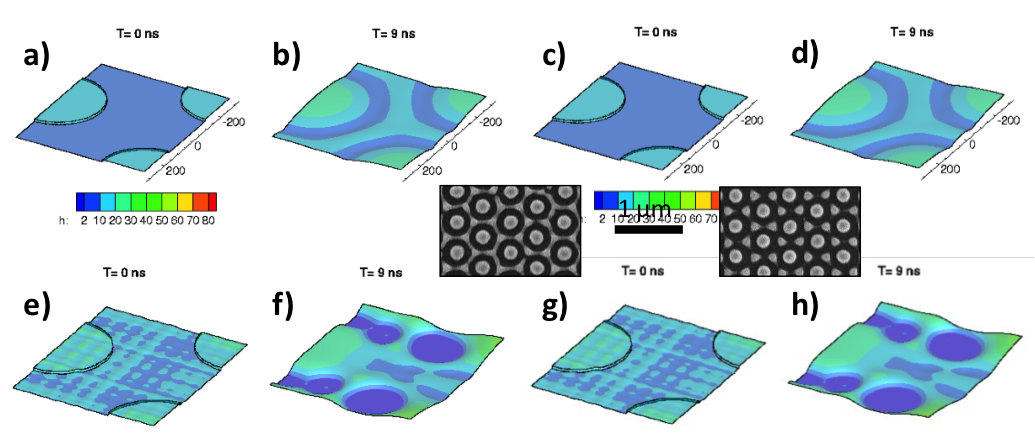
We
consider the evolution and related instabilities of thin metal films
liquefied by laser pulses. The films are patterned by
large-scale perturbations and we discuss how these perturbations
influence the dynamics. In the experiments, we find
that the considered thin films dewet, leading to the formation of
primary and secondary drops, with the locations of the primary ones
coinciding with the original perturbations. Based on the results
of the fully nonlinear time-dependent simulations, we discuss the
details of the evolution leading
to these patterns. Furthermore, in both experiments and
simulations, we discuss the influence of the shape of the initial
perturbations on the properties of the final patterns.
The figure shows combined simulations and experimental results
illustrating the instability mechanism. The bottom row
shows simulations where initial stochastic noise was included in the
simulations. The simulations are carried out withing the
long-wave model, reducing the problem to a nonlinear 4th order PDE.
Wu, Y., Dong, N., Fu, S., Fowlkes, J., Kondic, L., M. A. Vincenti, de Ceglia, D., Rack, P.,
Directed liquid phase assembly of highly ordered mettalic nanoparticle arrays, ACS Applied Materials and Interfaces, 6, 5835 (2014).
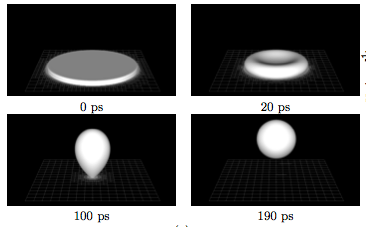
Metallic
nanoparticles, liquefied by fast laser irradiation, go through a rapid
change of shape attempting to minimize their surface energy. The
resulting nanodrops may be ejected from the substrate when the
mechanisms leading to dewetting are sufficiently strong, as in the
experiments involving gold nanoparticles [Habenicht et al., Science
309}, 2043 (2005)]. We use a direct continuum-level
approach to accurately model the process of liquid nanodrop formation
and the subsequent ejection from the substrate. Our
computations show a significant role of inertial effects and an
elaborate interplay of initial geometry and wetting properties: e.g.,
we can control the direction of ejection by prescribing
appropriate initial shape and/or wetting properties. The basic insight
regarding ejection itself can be reached by considering a simple
effective model based on an energy balance. We validate our
computations by comparing directly with the experiments specified
above involving the length scales measured in hundreds of
nanometers, and with molecular dynamics simulations on much shorter
scales measured in tens of atomic diameters, as in M.
Fuentes-Cabrera et al., Phys.~Rev. E 83, 041603 (2011). The
quantitative agreement, in addition to illustrating how to controlling
particle ejection, shows utility of continuum-based simulation in
describing dynamics on nanoscale quantitatively, even in a complex
setting as considered here.
Afkhami, S., Kondic, L.,
Numerical
simulation of ejected molten metal-nanoparticles liquefied by laser
irradiation: Interplay of geometry and dewetting,
Phys. Rev. Lett., 111, 034501 (2013).
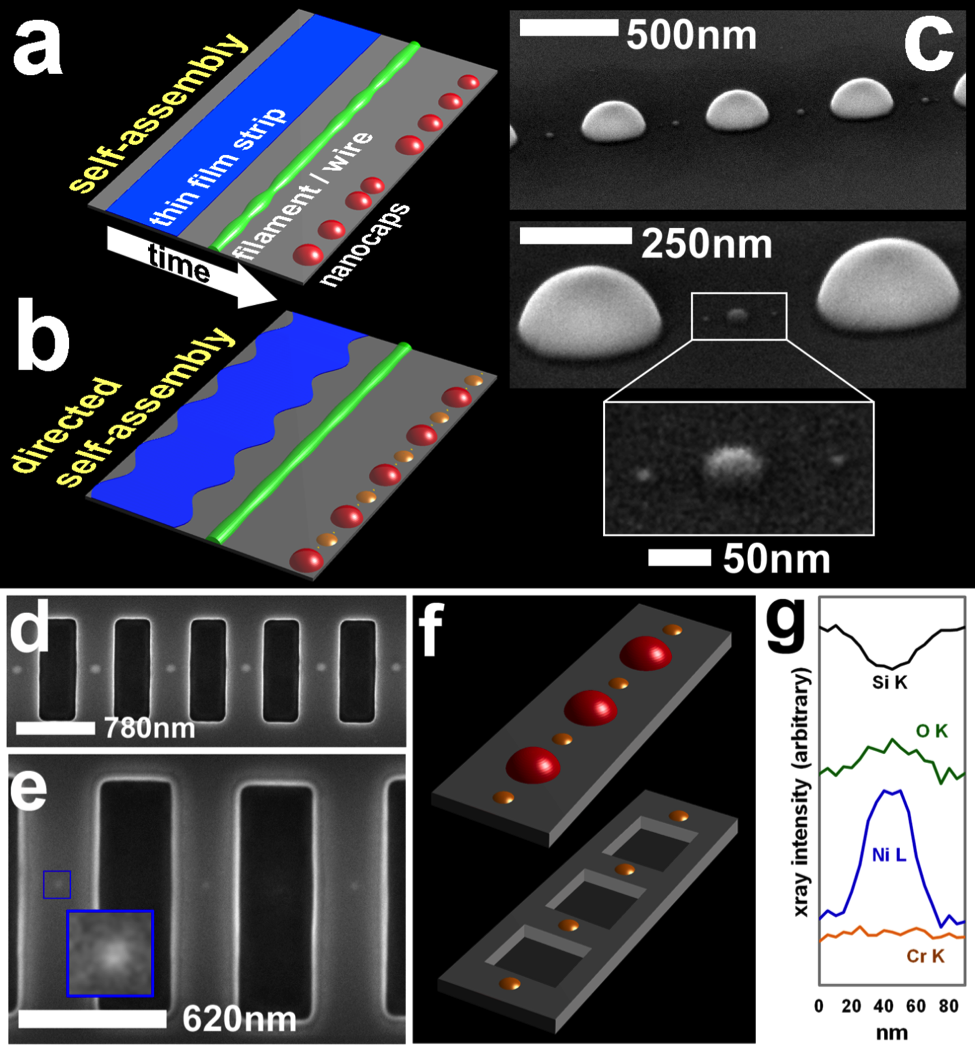
A liquid metal filament supported on a dielectric substrate was
directed to fragment into an ordered, mesoscale particle
ensemble. Imposing an undulated surface perturbation on the
filament forced the development of a single unstable mode from the
otherwise disperse, multimodal Rayleigh–Plateau instability. The
imposed mode paved the way for a hierarchical spatial fragmentation of
the filament into particles, previously seen only at much larger
scales. Ultimately, nanoparticle radius control is demonstrated
using a micrometer scale switch.
Fowlkes, J., Roberts, N., Wu Y., Diez, J., Gonzalez, A., Harnett C., Mahady, K., Afkhami, S., Kondic, L.,
Hierarchical Nanoparticle Ensembles Synthesized by Liquid Phase Directed Self-Assembly,
Nano Letters, 14, 774 (2014).
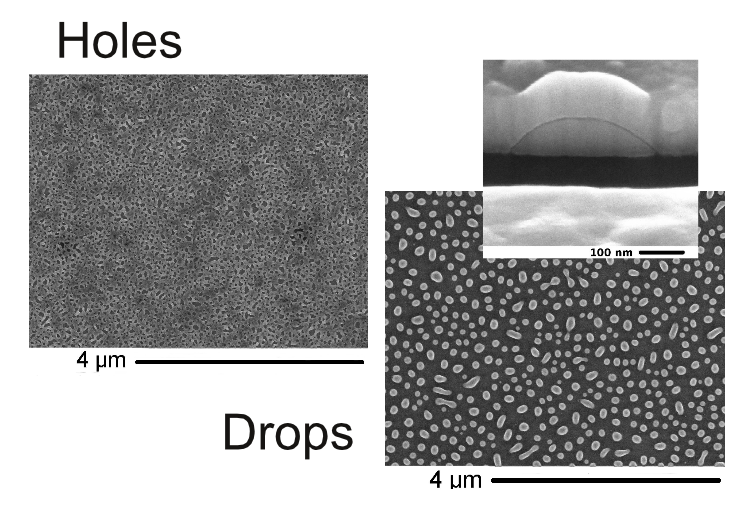
We study the instability of nanometric Cu thin films on a SiO2
substrate. The metal is melted by means of laser pulses for some tens
of nanoseconds, and during the liquid life time the free surface
destabilizes, leading to the formation of holes at first and then in
later stages of the instability to metal drops on the substrate. By
analyzing the Fourier transforms of the SEM (scanning electron
microscope) images obtained at different stages of the metal film
evolution, we determine the emerging length scales at relevant stages
of the instability development. The results are then discussed
within the framework of a long-wave model. We find that the results may
differ whether early or final stages of the instability are considered.
Based on the interpretation of the experimental results, we discuss the
influence of the parameters describing the interaction of the liquid
metal with the solid substrate. By considering both the dependence of
dominant length scales on the film thickness and the measured contact
angle, we isolate a model which predicts well the trends found in the
experimental data.
The figure shows the experimental images of two stagest of instability
with metal showing as light and the substrate as dark.
Gonzalez, A., Diez, J., Wu, Y., Fowlkes, J.j Rack, P.j Kondic, L.,
Instability of liquid Cu films on a SiO2 substrate,
Langmuir, 29, 9378 (2013).
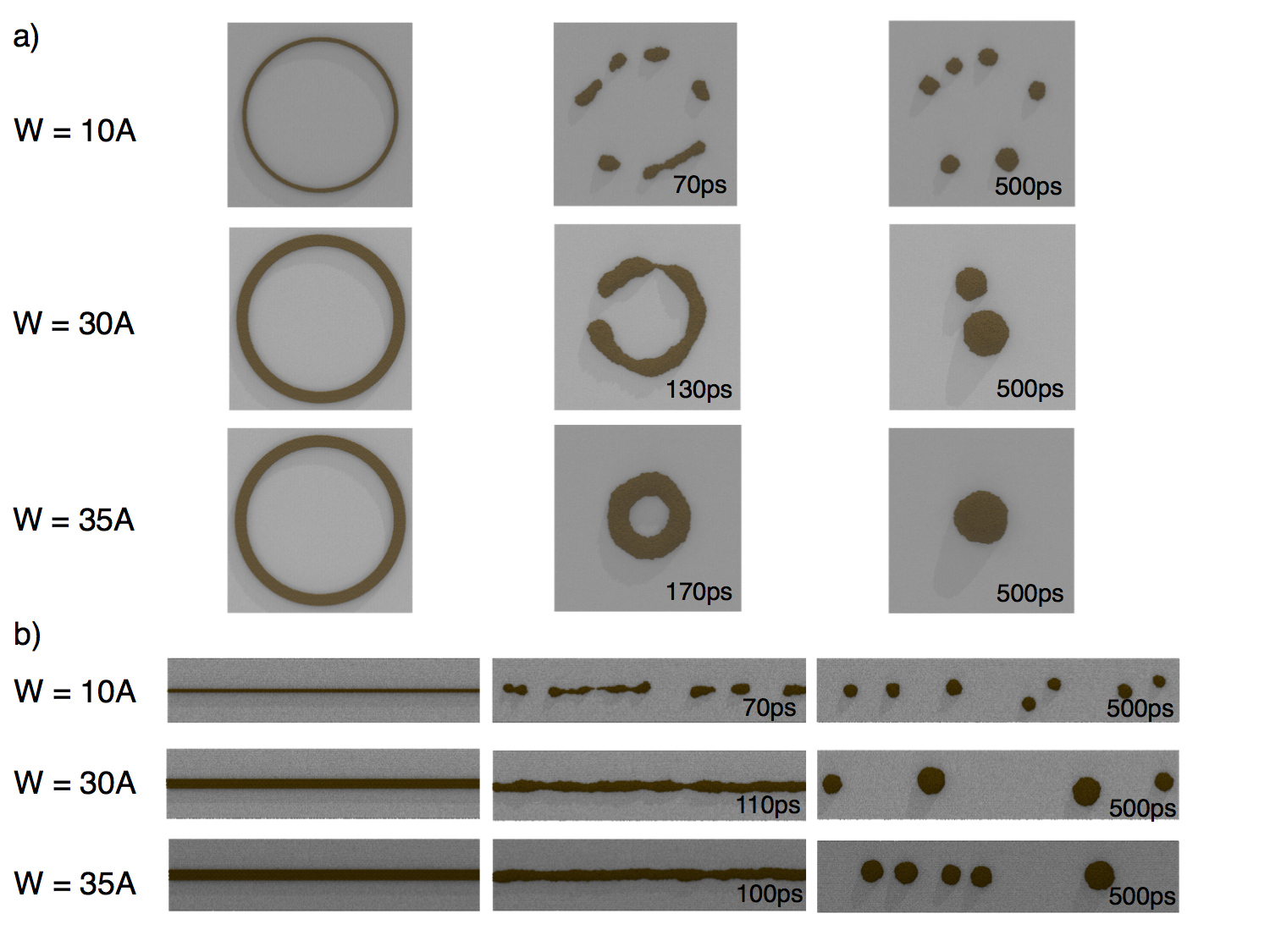
We
consider nanometer-sized fluid annuli (rings) deposited on a solid
substrate and ask whether these rings break up into droplets due to the
instability of Rayleigh-Plateau type modified by the presence of the
substrate, or collapse to a central drop due to the presence of
azimuthal curvature. The analysis is carried out by a combination of
atomistic molecular dynamics simulations and a continuum model based on
a long-wave limit of Navier Stokes equations. We find consistent
results between the two approaches, and demonstrate characteristic
dimension regimes which dictate the assembly dynamics.
The figure shows breakup (or lack of it) in MD simulations of rings and filaments.
Nguyen, T., Fuentes-Cabrera, M., Fowlkes, J., Diez, J., Gonzalez, A.G., Kondic, L., Rack, P.,
Competition between collapse and breakup in nanometer-sized thin rings using molecular dynamics and continuum modeling,
Langmuir, 28, 13960 (2012).
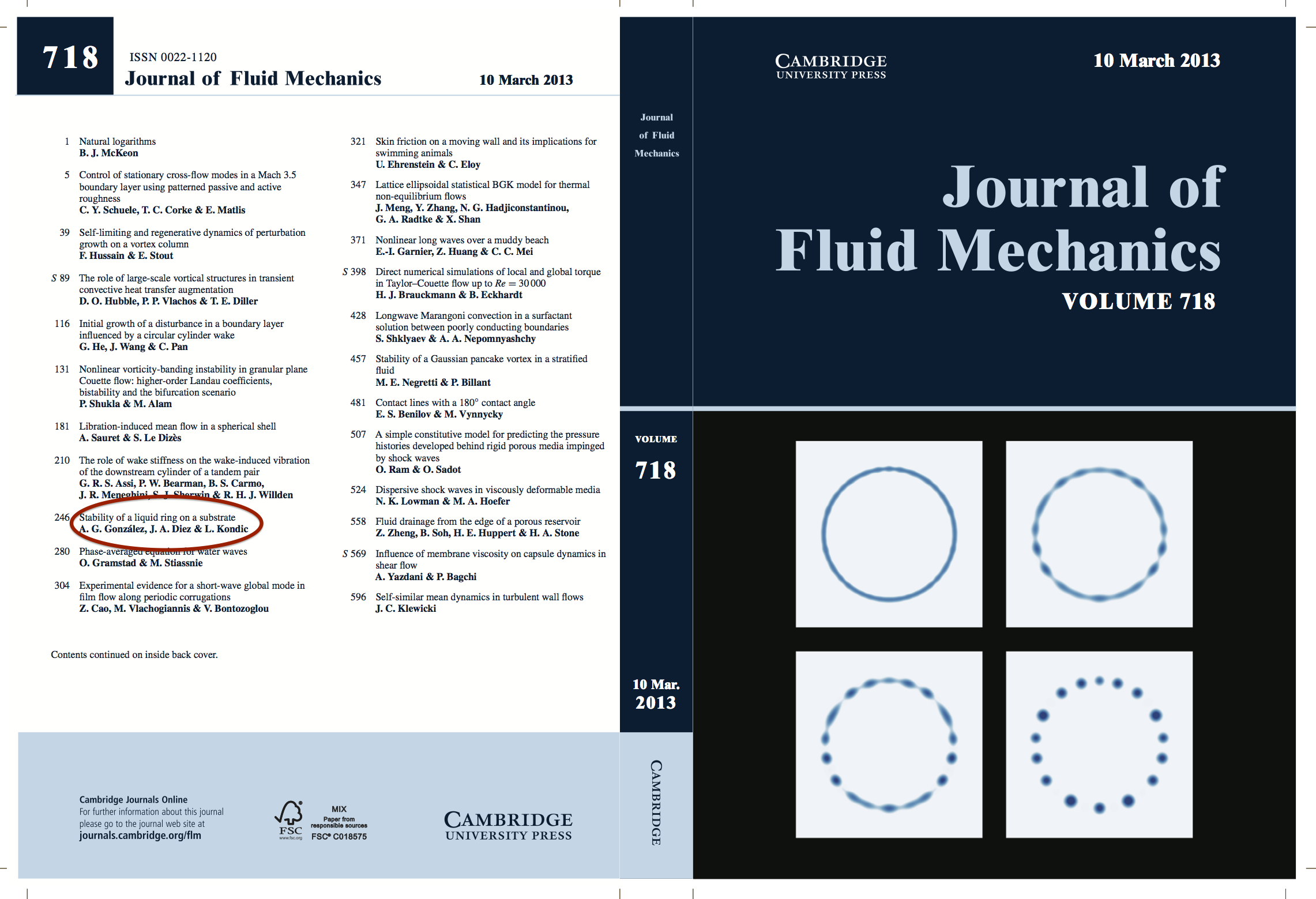
We study the stability of a viscous
incompressible fluid ring on a partially wetting substrate within
the framework of long-wave theory. We discuss the conditions
under which a static equilibrium of the ring is possible in the
presence of contact angle hysteresis. A linear stability analysis (LSA)
of this equilibrium solution is carried out by using a slip model to
account for the contact line divergence. The LSA provides
specific predictions regarding the evolution of unstable modes.
In order to describe the evolution of the ring for longer times, a
quasi-static approximation of Wentzel-Kramers-Brillouin (WKB) type is
implemented. This approach assumes a quasi-static evolution and
takes into account the concomitant variation of the instantaneous
growth rates of the modes responsible for either collapse of the
ring into a single central drop or breakup into a number of
droplets along the ring periphery. We compare the results of the
LSA and WKB with those obtained from nonlinear numerical simulations
using a complementary disjoining pressure model. We find
remarkably good agreement between the predictions of the two
models regarding the expected number of drops forming during the
breakup process.
Gonzalez, A., Diez, J., Kondic, L.,
Stability of a liquid ring on a substrate,
J. Fluid. Mech., 718, 246 (2013).
 We
consider the evolution and related instabilities of thin metal films
liquefied by laser pulses. The films are patterned by
large-scale perturbations and we discuss how these perturbations
influence the dynamics. In the experiments, we find
that the considered thin films dewet, leading to the formation of
primary and secondary drops, with the locations of the primary ones
coinciding with the original perturbations. Based on the results
of the fully nonlinear time-dependent simulations, we discuss the
details of the evolution leading
We
consider the evolution and related instabilities of thin metal films
liquefied by laser pulses. The films are patterned by
large-scale perturbations and we discuss how these perturbations
influence the dynamics. In the experiments, we find
that the considered thin films dewet, leading to the formation of
primary and secondary drops, with the locations of the primary ones
coinciding with the original perturbations. Based on the results
of the fully nonlinear time-dependent simulations, we discuss the
details of the evolution leading
 Metallic
nanoparticles, liquefied by fast laser irradiation, go through a rapid
change of shape attempting to minimize their surface energy. The
resulting nanodrops may be ejected from the substrate when the
mechanisms leading to dewetting are sufficiently strong, as in the
experiments involving gold nanoparticles [Habenicht et al., Science
309}, 2043 (2005)]. We use a direct continuum-level
approach to accurately model the process of liquid nanodrop formation
and the subsequent ejection from the substrate. Our
computations show a significant role of inertial effects and an
elaborate interplay of initial geometry and wetting properties: e.g.,
we can control the direction of ejection by prescribing
appropriate initial shape and/or wetting properties. The basic insight
regarding ejection itself can be reached by considering a simple
effective model based on an energy balance. We validate our
computations by comparing directly with the experiments specified
above involving the length scales measured in hundreds of
nanometers, and with molecular dynamics simulations on much shorter
scales measured in tens of atomic diameters, as in M.
Fuentes-Cabrera et al., Phys.~Rev. E 83, 041603 (2011). The
quantitative agreement, in addition to illustrating how to controlling
particle ejection, shows utility of continuum-based simulation in
describing dynamics on nanoscale quantitatively, even in a complex
setting as considered here.
Metallic
nanoparticles, liquefied by fast laser irradiation, go through a rapid
change of shape attempting to minimize their surface energy. The
resulting nanodrops may be ejected from the substrate when the
mechanisms leading to dewetting are sufficiently strong, as in the
experiments involving gold nanoparticles [Habenicht et al., Science
309}, 2043 (2005)]. We use a direct continuum-level
approach to accurately model the process of liquid nanodrop formation
and the subsequent ejection from the substrate. Our
computations show a significant role of inertial effects and an
elaborate interplay of initial geometry and wetting properties: e.g.,
we can control the direction of ejection by prescribing
appropriate initial shape and/or wetting properties. The basic insight
regarding ejection itself can be reached by considering a simple
effective model based on an energy balance. We validate our
computations by comparing directly with the experiments specified
above involving the length scales measured in hundreds of
nanometers, and with molecular dynamics simulations on much shorter
scales measured in tens of atomic diameters, as in M.
Fuentes-Cabrera et al., Phys.~Rev. E 83, 041603 (2011). The
quantitative agreement, in addition to illustrating how to controlling
particle ejection, shows utility of continuum-based simulation in
describing dynamics on nanoscale quantitatively, even in a complex
setting as considered here. 

 We
consider nanometer-sized fluid annuli (rings) deposited on a solid
substrate and ask whether these rings break up into droplets due to the
instability of Rayleigh-Plateau type modified by the presence of the
substrate, or collapse to a central drop due to the presence of
azimuthal curvature. The analysis is carried out by a combination of
atomistic molecular dynamics simulations and a continuum model based on
a long-wave limit of Navier Stokes equations. We find consistent
results between the two approaches, and demonstrate characteristic
dimension regimes which dictate the assembly dynamics.
We
consider nanometer-sized fluid annuli (rings) deposited on a solid
substrate and ask whether these rings break up into droplets due to the
instability of Rayleigh-Plateau type modified by the presence of the
substrate, or collapse to a central drop due to the presence of
azimuthal curvature. The analysis is carried out by a combination of
atomistic molecular dynamics simulations and a continuum model based on
a long-wave limit of Navier Stokes equations. We find consistent
results between the two approaches, and demonstrate characteristic
dimension regimes which dictate the assembly dynamics. 